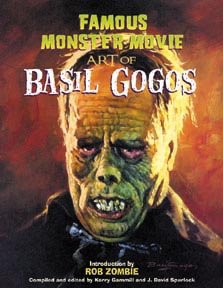
FAMOUS MONSTER MOVIE ART OF BASIL GOGOS
Compiled and edited by Kerry Gammill and J. David Spurlock
Vanguard Productions (390 Campus Drive, Somerset NJ 08873, vanguardpub@att.net), 160 pages (softcover, hardcover), 176 pages (deluxe hardcover), $24.95 (sc), $34.95 (hc) or $59.95 (dx hc) plus $6.95 shipping
THIS BEAUTIFULLY DESIGNED art book by Kerry Gammill and J. David Spurlock is the first to pay tribute to Basil Gogos, the Michelangelo of the Macabre. The basic edition, available in soft and hardcover, collects more than 150 color illustrations from Gogos' 40+ year career in book and magazine illustration (many reproduced from the original art) and more than 50 in B&W, while a deluxe edition limited to 600 slipcased copies, signed by the artist, adds an additional 16 page portfolio in color. Some may quibble that the portfolio contains a repeated image from the main pages, but it is substantially enlarged, further enhancing one's appreciation of what went into it. According to publisher J. David Spurlock, the deluxe edition was an instant sell-out with retailers and is now available only from Vanguard,while supply lasts. Those able to afford (and find) the limited edition are advised to shoot for the moon.
Despite the specificity of its title, FAMOUS MONSTER MOVIE ART OF BASIL GOGOS devotes about 40 of its pages to Gogos' paperback, Western, and men's magazine art, some of which is quite good, but none of which strikes the profound chords of his monster portraiture. Paging through the monster cover portraits collected here, one is continually struck by their amazing powers of reference.
The HOUSE OF USHER painting that started it all on the cover of FAMOUS MONSTERS OF FILMLAND #9 is a classic case in point: in its coarse caulky outlines, bleachy tonalities, and uncanny flecks of irrational color, it seems to define in visual terms the relationship between Roderick Usher's (Vincent Price's) disintegrating mind and family hearth. One of Gogos' greatest works, his rendering of Fredric March's Mr. Hyde for the cover of FAMOUS MONSTERS #62, facets the distorted, bedraggled features of Dr. Jekyll's alter ego with so many daubs of fantasmagorical color (lavenders, lime greens, sunny yellows) that we can imagine how Rouben Mamoulian's B&W film might have looked under the painterly direction of Mario Bava.
There is something about the way Gogos paints the cold blue light striking the combed hair of Christopher Lee's Count Dracula (MONSTERSCENE #3) that summons the entire flavor of the experience that is HORROR OF DRACULA. Gogos' uncommonly impressionistic, almost sketchy painting of Ingrid Pitt for the cover of MONSTERSCENE #8 captures the vivacity of its subject in an unexpected cocktail of colors. It's so alive that one's impression of the painting is one of startling brightness, though the work itself is more than half-based in dark hues. When tackling a subject as seemingly soulless as the prehistoric GORGO (FAMOUS MONSTERS #11 and 50), Gogos somehow imbues the image with a sense of gigantism and primordial power that one would imagine beyond the province of a page dimension usually reserved for characters of human proportion. Even something as rudimentary as a charcoal sketch of Henry Hull in WERE-WOLF OF LONDON miraculously captures the whole truth of the actor's body language and threatens to leap snarling off the page.
There are also many, many instances in which Gogos' oils and acrylics provide his subjects with atmospheric settings far in excess of any they ever received onscreen. Jonathan Frid makes his greatest bid for immortality as Barnabas Collins not on the videotape of DARK SHADOWS or in its theatrical spin-off, but in the oils of Gogos on the cover of FAMOUS MONSTERS #59. One aches to see the Technicolor Wolf Man movie starring Lon Chaney sampled on p. 156. Looking at King Kong on p. 153, his face looming with godly majesty and ungodly delight, we experience the same awe and revulsion and terror we imagine Ann Darrow must have felt when lashed to those sacrificial posts on Skull Island. For dyed-in-the-wool monster fans, almost every page of this book offers that kind of rich, emotional experience.

Despite a blandish accompanying text that doesn't fully succeed in revealing the man behind the art or the reasons for his singular affinity for these subjects, FAMOUS MONSTER MOVIE ART OF BASIL GOGOS keeps its promise of collecting and paying tribute to Gogos' work superbly. It covers his diversity as an artist both reasonably and fairly, while accentuating the monster paintings where he found his most lasting success. The art reproductions alone are worth the cost of the book in any edition. A fair amount of digital restoration was likely involved in refreshing these works for print, and it is to the designers' credit that such work is absolutely invisible.
Of course, Gogos is still living his story and his growing legacy may well inspire other books in time. Future volumes on the subject may cut deeper, but they will need to go to superhuman lengths to be more beautiful or more loving than this one.
________
Note: A longer and more detailed draft of this review will appear in VIDEO WATCHDOG #125.